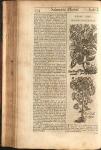

 I. The Names. It is called in Greek**********, in Latin, Xanthium: In the Shops, Lappa minor, Lappa inversa; and by some, Strumaria and Bardana minor: In English, the Lesser or Small Burdock.
I. The Names. It is called in Greek**********, in Latin, Xanthium: In the Shops, Lappa minor, Lappa inversa; and by some, Strumaria and Bardana minor: In English, the Lesser or Small Burdock.
II. The Kinds. It is the lesser sort of the Burdocks, and singular of the Kind.
 III. The Description. It has a small Root somewhat long and fibrous, and perishing every year: from which Root rises up a rough crested Stalk, about two feet high, breaking out into several Branches, with many blackish spots upon them, with two much smaller and whiter Leaves at every Joint, standing upon long Footstalks, which Leaves are usually divided into three parts, something like unto a Marsh Mallow leaf, unevenly notched or dented about the edges: at the Joints of the Stalk and Branches with the Leaves, towards the tops of them, come forth small Flowers, which abide not long; and after them, two or three small Flowers which abide not long; and after them, two or three small, close Burs, a little pointed at the top, wherein lye two or three small lank Seeds, somewhat like unto an Oat, which fall not out, nor do the heads open.
III. The Description. It has a small Root somewhat long and fibrous, and perishing every year: from which Root rises up a rough crested Stalk, about two feet high, breaking out into several Branches, with many blackish spots upon them, with two much smaller and whiter Leaves at every Joint, standing upon long Footstalks, which Leaves are usually divided into three parts, something like unto a Marsh Mallow leaf, unevenly notched or dented about the edges: at the Joints of the Stalk and Branches with the Leaves, towards the tops of them, come forth small Flowers, which abide not long; and after them, two or three small Flowers which abide not long; and after them, two or three small, close Burs, a little pointed at the top, wherein lye two or three small lank Seeds, somewhat like unto an Oat, which fall not out, nor do the heads open.
IV. The Places. It grows in many places of this Kingdom, as particularly in two or three places between Tidenham and Chepstow, in the foot way; in the Highway between Stanes and Egham, and between Drayton and Iver, two Miles from Colebrook; and at Southwick-sheet in Hampshire.
V. The Times. It Flowers and Seeds when the great Burdock does; viz. in the Summer Months, June, July and August.
VI. The Qualities. It is temperate as to heat and cold, dryness and moisture, yet Galen will have the Seeds to be hot and dry, digestive, also discuissive, Neurotick, Splenetick, and Hysterick; Alterative, and Alexipharmick.
VII. The Specification. It is singular against the pain and hardness of the Spleen.
1. The Juice.
2. The Essence.
3. The Saline Tincture.
4. The Oily Tincture.
5. A Pouder of the Root.
6. A Pouder of the Seed.
7. A Conserve of the Roots.
8. A Salt.
9. A Decoction of the Roots.
10. A Lotion, or Wash.
11. A Cataplasm of the Roots or Seeds.
The Virtues.
IX. All these Preparations have the same Virtues, Uses, and Doses, with those of the same name in the Chapter of the Great Burdock, to which you are referr'd; but there are some peculiar Virtues in this Plant, not observed to be inherent in the former, for which reason we shall say something more of its Essence, Decoction, Lotion, and Cataplasm, in the Sections following.
X. The Essence. It strikes at the Root of the Leprosie, prevails against Faintings and Swoonings, opens Obstructions of Liver and Spleen, but more especially of the last, and gives ease in pains of the Hypochonders and Bowels. Dose three or four spoonfuls Morning and Evening in a Glass of Sherry Wine.
XI. The Decoction. It is to be made with Wine: and has the Virtues of the Essence , it consumes the hardness of the Spleen, being taken inwardly Morning, Noon, and Night, to six ounces, and as often bathed warm upon the part affected.
XII. The Lotion. It is made of the Burs, before they are ripe, being bruised and laid to steep in Water, or Wine, in which a little Nitre is dissolved, for twenty four hours. It discusses Tumors, and gives ease in Pains, being bathed warm upon the parts affected. If the Hair is sometimes washed therewith, it makes it become yellow. It is an excellent Gargle for a sore Mouth and Throat, taking away the Inflammation, and healing of it in a very short time.
XIII. The Cataplasm. It is made of the Roots or Green Burs, being beaten to a Pap in a Mortar, and mixed with a third part of Mithridate. Being applied upon hard Kernels, or Swellings in the Flesh (as those proceeding from the Kings-Evil) it is said to soften and dissolve them: but more especially, if in the mean season, the juice, Essence or Decoction in Wine aforementioned be daily given inwardly two, three or four ounces at a time, and that Morning, Noon, and Night; for these Preparations very much sweeten the Blood and Juices; and correct the Discrasie of the Humors.
Botanologia, or The English Herbal, was written by William Salmon, M.D., in 1710.
This chapter has been proofread by Nick Jones.

